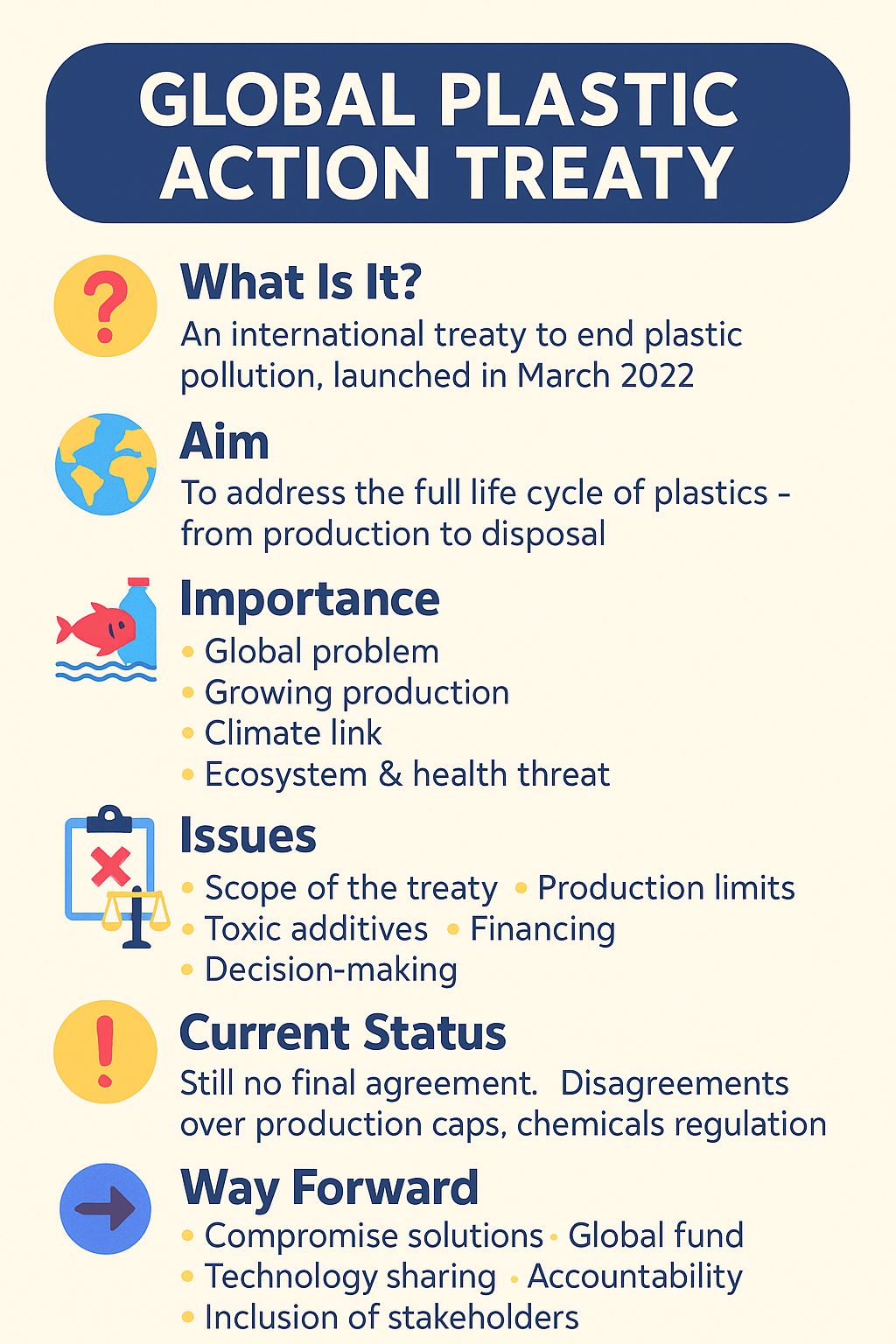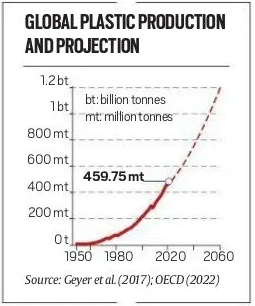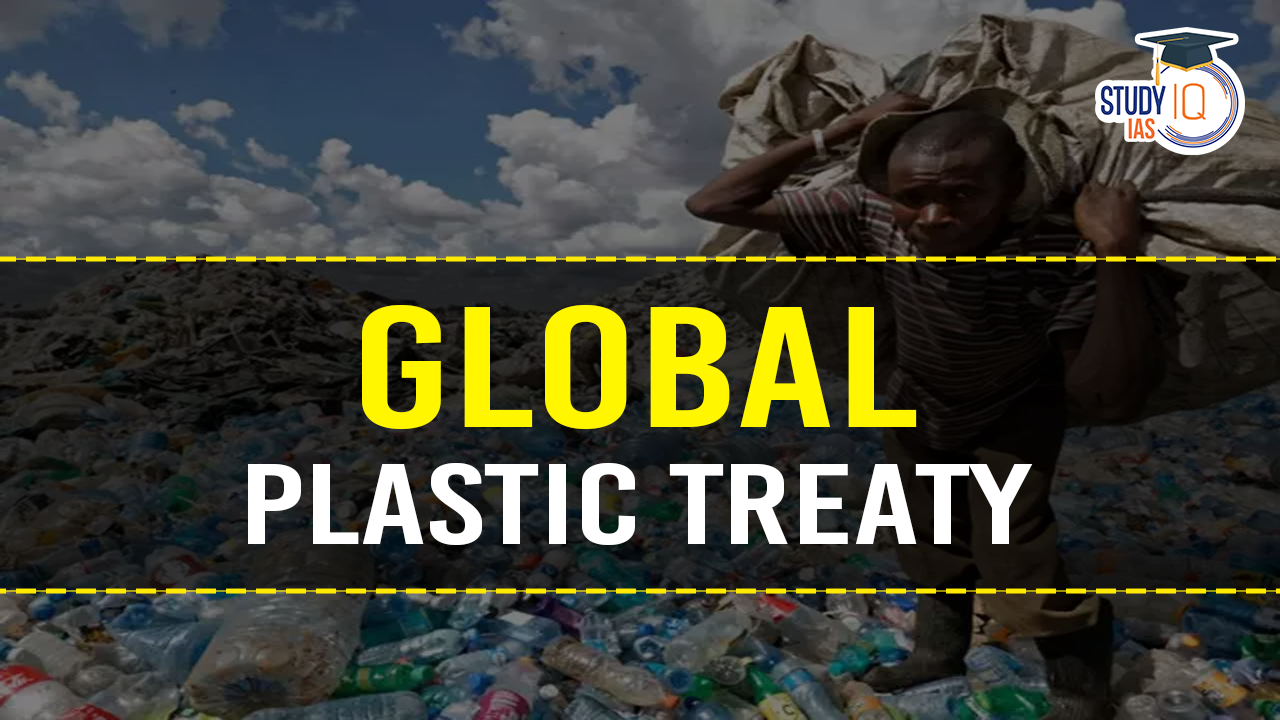Table of Contents
Context: According to OECD’s Global Plastic Outlook, plastic production doubled from 2000 to 2019, reaching 460 million tonnes, while waste grew to 353 million tonnes.
| Current Status of Global Plastic Production |
|
Why is Plastic Pollution Increasing?
- High Consumption and Demand: Economic growth, urbanisation, and rising incomes mean more packaged goods → more use of plastics.
- Design and Production Issues: Many plastics (like multi-layered packaging) are hard to reuse or recycle.
- Weak Waste Management: Poor collection, segregation, and transport systems. Lack of recycling plants and funding in cities and towns.
- Governance Gaps: Rules exist but are weakly enforced. Producers and brands are not made fully responsible (EPR issues).
- Economic Barriers: Eco-friendly alternatives are often costlier or unavailable.
Recycling is costly and less profitable. - Behavioural and Cultural Factors: People prefer plastic for convenience. Low awareness about pollution and health effects.
- Global Trade and Supply Chains: Some countries dump or export plastic waste. The oil and gas industry promotes plastic production for profits.
Global Plastic Treaty Overview
- The Global Plastics Treaty, supported by at least 175 United Nations member nations, aims to curtail the use of plastics through a legally binding document.
- The treaty’s objectives include setting timelines to reduce plastic production, eliminate wasteful uses, ban harmful chemicals involved in plastic production, and establish recycling targets.
- The goal is to finalise this treaty by the end of 2024.

Check here the impact of Plastic Pollution in detail!
Need for a Global Plastics Treaty
Plastic pollution is a global crisis
- Production skyrocketed from 2 million tonnes in 1950 to 450 million tonnes in 2019.
- Expected to double by 2050 and triple by 2060.
- Less than 10% of plastic waste is recycled.
- 6 billion tonnes currently pollute the planet.
- 400 million tonnes of plastic waste generated annually (projected 62% increase by 2050).

Plastic harms ecosystems and human health
- Breaks down into microplastics containing harmful chemicals.
- Disrupts human hormones and is linked to cancer, diabetes, and reproductive disorders.
Plastic production contributes to climate change
- Generates 1.8 billion tonnes of greenhouse gas emissions annually (3.4% of global emissions).
- Projected 20% increase in emissions from plastic production by 2050.
Challenges to the Global Plastic Treaty
- Opposition from Oil-Producing Countries and Industry Groups: Countries with significant oil and gas interests, like Saudi Arabia, Russia, and Iran, along with fossil fuel and chemical industry groups, are trying to limit the scope of the treaty.
- They prefer focusing on plastic waste management and recycling rather than imposing caps on plastic production.
| Fact |
| A coalition of African countries, with support from several European nations, advocates for a definitive timeline around 2040 for reducing plastic usage. |
- Procedural Disagreements: There have been numerous delays due to disagreements over procedural issues, such as the decision-making process for the treaty.
- The choice between achieving consensus (which allows any single country to veto the treaty) versus majority voting remains unresolved, complicating the negotiations.
- Industry Lobbying: The chemical and fossil fuel industries have sent a record number of lobbyists to the negotiation sessions.
- These lobbyists work to weaken the treaty’s provisions, emphasising that the crisis is more about waste management than reducing plastic production itself.
- Lack of Consensus Among Countries: While a coalition of around 65 nations (the High Ambition Coalition) is pushing for comprehensive measures to tackle plastic pollution, other countries, notably the United States, advocate for voluntary steps rather than mandatory actions, reflecting a broader lack of consensus on the treaty’s goals and methods.
- Scale and momentum of production: Production capacity keeps growing. Stopping leakage only through cleanup is insufficient.
- Fragmented responsibilities. Multiple actors (producers, brands, municipalities, citizens) & lack of coordination.
- Informal Sector Issues: In many countries (including India), a lot of waste picking / recycling is done by informal workers. They have little support.
- Technological limits. Some plastics cannot be recycled economically or safely.
- Finance and incentives. Developing countries need funds to build modern recycling and collection infrastructure.
- International politics. Fossil-fuel producing countries and industry lobbyists resist measures that limit production. This complicates global agreements.
- Global Disagreements: On what actions are fair or feasible for different countries. E.g. limiting production of plastic vs only addressing waste.
India’s Position on the Global Plastic Treaty
- India, while not opposed to the treaty, insists that it must include provisions for the availability, accessibility, and affordability of alternatives.
- India’s stance reflects the principle of ‘common but differentiated responsibility‘ often discussed in climate agreements, which argues that while all countries should meet common targets, wealthier nations should assume greater responsibilities and provide support to less affluent ones.
Domestic Actions in India
- In 2022, India implemented the Plastic Waste Management Amendment Rules (2021), which banned 19 types of single-use plastics.
- The ban does not cover plastic bottles under 200 ml and multi-layered packaging such as milk cartons.
- Enforcement of this ban is inconsistent across the country, with many outlets still selling the banned items.
Global Impact of Plastic Pollution
- The global distribution of plastic pollution is heavily skewed, with Brazil, China, India, and the U.S. contributing to 60% of the world’s plastic waste.
- Addressing plastic pollution effectively requires significant investment in developing affordable alternatives to current plastic products.
Global & Indian Efforts to Tackle the Global Plastic Pollution Crisis
Global Efforts
- UN Environment Assembly (2022): All 193 UN member states agreed to negotiate a legally binding treaty to end plastic pollution.
- UNEP’s Target: Reduce plastic waste by 80% in two decades through innovation, better product design, alternatives, and efficient waste management.
- Cleanup and innovation: Organisations remove plastic from rivers and oceans and pilot new interception technologies.
Indian Government Efforts
- Plastic Waste Management Rules → Extended Producer Responsibility (EPR).
- Ban on Identified Single-Use Plastic (SUP) Items.
- Rules on the thickness of plastic bags (Plastic carry bags below a certain thickness are banned).
Way Forward
- Adopt life-cycle approach: Regulate design, production, use, and disposal together.
- Set global targets: Reduce virgin plastic production and packaging, not just manage waste.
- Provide finance & technology: Support developing countries to build recycling and waste systems.
- Strengthen EPR: Make producers responsible for collection and recycling.
- Level market incentives: Make recycled plastic competitive through taxes, subsidies, or mandatory recycled content.
- Change behaviour: Raise awareness, ensure household segregation, promote reuse.
- Support informal workers: Integrate waste pickers into formal systems with protection and incentives.
- Finalize global treaty: Resolve disputes on production limits and finance to make the plastics treaty effective.


 List of National Parks in India 2025, Ch...
List of National Parks in India 2025, Ch...
 Bonnet Macaques: Habitat, Features, Beha...
Bonnet Macaques: Habitat, Features, Beha...
 Periyar Tiger Reserve, Map, Flora, Fauna...
Periyar Tiger Reserve, Map, Flora, Fauna...

























